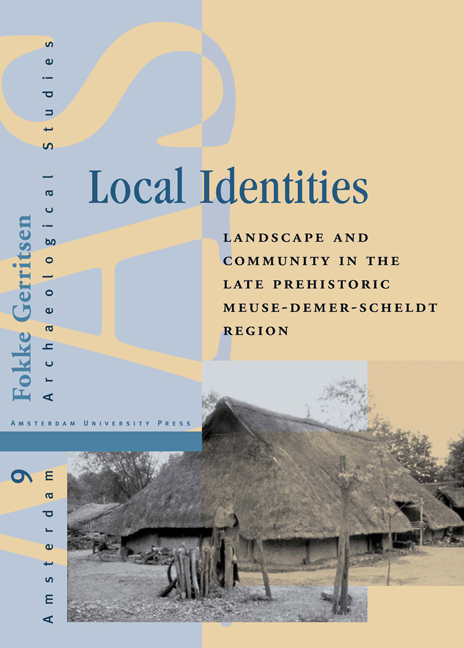Book contents
- Frontmatter
- Contents
- Acknowledgment
- 1 Introduction
- 2 Archaeology in a Sandy ‘Essen’ Landscape
- 3 The House and its Inhabitants
- 4 Local Communities and the Organisation of the Landscape
- 5 Micro-Regional and Regional Patterns of Habitation, Demography and land use
- 6 Landscape, Identity and Community in the First Millennium BC
- Abbreviations
- References
- Appendix 1 Meuse-Demer-Scheldt Region. Distribution of Urnfields
- Appendix 2 Catalogus of Urnfields
- Index of Geographical Names
2 - Archaeology in a Sandy ‘Essen’ Landscape
Published online by Cambridge University Press: 28 January 2021
- Frontmatter
- Contents
- Acknowledgment
- 1 Introduction
- 2 Archaeology in a Sandy ‘Essen’ Landscape
- 3 The House and its Inhabitants
- 4 Local Communities and the Organisation of the Landscape
- 5 Micro-Regional and Regional Patterns of Habitation, Demography and land use
- 6 Landscape, Identity and Community in the First Millennium BC
- Abbreviations
- References
- Appendix 1 Meuse-Demer-Scheldt Region. Distribution of Urnfields
- Appendix 2 Catalogus of Urnfields
- Index of Geographical Names
Summary
The Meuse-Demer-Scheldt (MDS) region is a Pleistocene coversand plateau of approximately 250 kilometres (east-west) by 120 kilometres (north-south) (fig. 2.1). It covers the modern-day province of Noord-Brabant and the sandy parts of Dutch Limburg in the Netherlands, and the provinces of Antwerp and Limburg in Belgium.To the north of the sandy landscapes of the MDS region lies a broad zone with Holocene Meuse and Rhine sediments.The western edge of the study area is formed by the delta region of these rivers and the Scheldt river.To the south and east of the MDS region lie the loamy sand and loess regions of Belgium, southern Dutch Limburg and the German Rhineland.Together these features define the MDS region as a geographical entity.
With respect to geographical situation, long-term structure of the agrarian economy, and potential for archaeological study, the MDS region is comparable to the other coversand landscapes or Geestlandschaften that form a series along the south coast of the North Sea. In this chapter I will present the main issues that set the parameters for archaeological research in a coversand landscape in general and the MDS region in particular.These are the geological and geomorphological situation, the general structure of the landscape in premodern times, and the history of archaeological investigations in the study area.
ASPECTS OF GEOLOGY AND GEOMORPHOLOGY
The highest part of the MDS region is situated in the southeast and rises a little over 100 metres above sea level. From there the terrain gently drops down to about sea level at the northwestern border.The main geomorphological element in most of this region consists of sand deposits that were laid down under cold and dry conditions during and after the last Ice Age. They overlie older aeolian sands and riverine sand and gravel sediments. The coversands are mostly between half a metre and one and a half metres thick and consist of fine to coarse sands, sometimes with an admixture of loam.They form low, elongated ridges following a general southwesterly to northeasterly direction. In the northwestern border area peat and marine clays are the dominant element. Even though strictly speaking this border area is part of the MDS region, it will not be taken into account in this study; very little is known about the prehistoric habitation of this area.
- Type
- Chapter
- Information
- Local IdentitiesLandscape and Community in the Late Prehistoric Meuse-Demer-Scheldt Region, pp. 17 - 30Publisher: Amsterdam University PressPrint publication year: 2003



